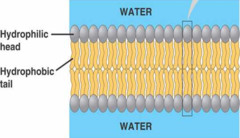Cell membrane structure and functions
| 459399805 | Selective Permeability | Allows some substances to cross more easily than others | |
| 459399806 | Amphipathic | molecule that has both a hydrophillic region and a hydrophobic region such as a phosopholipid |  |
| 459399807 | phospholipid bilayer | a double layer of phospholipids that makes up plasma membranes |  |
| 459399808 | Integral Proteins | Proteins that extend through the phospholipid bilayer. |  |
| 459399809 | Peripheral Proteins | A protein loosely attached to the surface of a membrane |  |
| 459399810 | Glycoproteins | proteins that have carbohydrates covalently bonded to them, | |
| 459399811 | cholesterol | steroid present in the plasma membranes of animal cells. A large amount of this in a phospholipid bilayer at High Temperatures reduces membrane fluidity, but at Lower Temperature prevents the membrane from solidifying. |  |
| 459399812 | Diffusion | the movement of molecules from an area of higher concentration to an area of lower concentration, so that they spread out evenly reaching equilibrium |  |
| 459399813 | Osmosis | The diffusion of water across a selectively permeable membrane | |
| 459399814 | Transport Proteins | use energy (ATP) to transport materials across the membrane. Active transport... |  |
| 459399815 | Aquaporins | Channel proteins that help massive amount of water pass through the membrane; a lot in our kidneys | |
| 459399816 | Passive Transport | movement of materials through a cell membrane without using energy | |
| 459399817 | Isotonic | a solution whose solute concentration equals that inside a cell; the cell will not change |  |
| 459399818 | Hypertonic | the solution with the greater concentration of solutes than that inside the cell; the cell will lose water to its environment--> Cell will shrivel up |  |
| 459399819 | Hypotonic | the solution with the lower concentration of solutes than that inside the cell; water will enter the cell -> Cell will swell and burst |  |
| 459399820 | Osmoregulation | The control of water balance | |
| 459399821 | Turgid | Very firm (healthy state), especially for plant cells | |
| 459399822 | Plasmolysis | As a plant cell shrivels its plasma membrane pulls away from the wall |  |
| 459399823 | Facilitated Diffusion | passive transport of ions or polar molecules across a plasma membrane by transport proteins |  |
| 459399824 | Active Transport | transport of a substance through a cell membrane against the concentration gradient; requires energy |  |
| 459399825 | Sodium-Potassium Pump | a carrier protein that uses ATP to actively transport sodium ions out of a cell and potassium ions into the cell |  |
| 459399826 | Exocytosis | process by which a cell releases large amounts of material by vesicles |  |
| 459399827 | Endocytosis | the movement of a substance into a cell by a vesicle | |
| 459399828 | Phagocytosis | a type of endocytosis in which microbes are taken in by immune cells of animals (mainly by macrophages) |  |
| 459399829 | Pinocytosis | cellular drinking |  |
| 459399830 | Receptor-mediated endocytosis | Taking in large amount of specific substances by binding to receptors, which form vesicles and are then taken in by the cell |  |
| 459399831 | osmotic pressure | The force required to resist the movement of water by osmosis. Osmotic pressure is a measure of the concentration of a solution. A solution that is highly concentrated has a strong tendency to draw water into itself, so the pressure required to resist that movement would be high. Thus, highly concentrated solutions are said to have high osmotic pressures. | |
| 459399832 | recognition protein | A protein or glycoprotein protruding from the outside surface of a plasma membrane that identifies a cell as belonging to a particular species, to a specific individual of that species, and in many cases to one specific organ within the individual. (self cells and foreign cells) | |
| 459399833 | Channel protein | A membrane protein that forms a channel or pore completely through the membrane and that is usually permeable to one or to a few water-soluble molecules, especially ions. | |
| 459399834 | ion channels | channel proteins that transport ions | |
| 459399835 | porins | Proteins that allow the passage of certain ions and small polar molecules through membranes? | |
| 459399836 | carrier proteins | transport proteins that can bind to a specific substance on one side of the cell membrane, carry the substance across the cell membrane and release it on the other side. | |
| 459399837 | adhesion proteins | attach cells to neighboring cells or provide anchors for the internal filaments and tubules that give stability to the cell | |
| 459399838 | receptor proteins | protein providing binding sites for hormones or other trigger molecules. In response to the hormone or trigger molecule, a specific cell response is activated | |
| 459399839 | glycolipids | lipid substances with linked sugar groups that are key structural elements in cell membranes and precursors of other biologically active molecules important in cell signaling | |
| 459399840 | lipid | Any of a group of large biological molecules, including fats, phospholipids, and steroids, that mix poorly, if at all, with water. |

